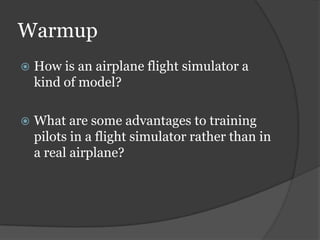P2.3 Scientific Models
•Télécharger en tant que PPTX, PDF•
2 j'aime•3,227 vues
Signaler
Partager
Signaler
Partager

Recommandé
Recommandé
Contenu connexe
Tendances
Tendances (20)
Chemistry - Chp 3 - Scientific Measurement - PowerPoint

Chemistry - Chp 3 - Scientific Measurement - PowerPoint
For 9th grade Physics, chapter 6 "Energy transformations and energy transfers"

For 9th grade Physics, chapter 6 "Energy transformations and energy transfers"
Similaire à P2.3 Scientific Models
Similaire à P2.3 Scientific Models (20)
Principles of Health Informatics: Models, information, and information systems

Principles of Health Informatics: Models, information, and information systems
Science Subject for Elementary - 1st Grade_ Physical Science by Slidesgo.pptx

Science Subject for Elementary - 1st Grade_ Physical Science by Slidesgo.pptx
1. According to the readings, philosophy began in ancient Egypt an.docx

1. According to the readings, philosophy began in ancient Egypt an.docx
Plus de mlong24
Plus de mlong24 (20)
Dernier
God is a creative God Gen 1:1. All that He created was “good”, could also be translated “beautiful”. God created man in His own image Gen 1:27. Maths helps us discover the beauty that God has created in His world and, in turn, create beautiful designs to serve and enrich the lives of others.
Explore beautiful and ugly buildings. Mathematics helps us create beautiful d...

Explore beautiful and ugly buildings. Mathematics helps us create beautiful d...christianmathematics
Dernier (20)
Explore beautiful and ugly buildings. Mathematics helps us create beautiful d...

Explore beautiful and ugly buildings. Mathematics helps us create beautiful d...
Measures of Central Tendency: Mean, Median and Mode

Measures of Central Tendency: Mean, Median and Mode
Mixin Classes in Odoo 17 How to Extend Models Using Mixin Classes

Mixin Classes in Odoo 17 How to Extend Models Using Mixin Classes
Russian Escort Service in Delhi 11k Hotel Foreigner Russian Call Girls in Delhi

Russian Escort Service in Delhi 11k Hotel Foreigner Russian Call Girls in Delhi
Measures of Dispersion and Variability: Range, QD, AD and SD

Measures of Dispersion and Variability: Range, QD, AD and SD
Ecological Succession. ( ECOSYSTEM, B. Pharmacy, 1st Year, Sem-II, Environmen...

Ecological Succession. ( ECOSYSTEM, B. Pharmacy, 1st Year, Sem-II, Environmen...
Z Score,T Score, Percential Rank and Box Plot Graph

Z Score,T Score, Percential Rank and Box Plot Graph
This PowerPoint helps students to consider the concept of infinity.

This PowerPoint helps students to consider the concept of infinity.
Presentation by Andreas Schleicher Tackling the School Absenteeism Crisis 30 ...

Presentation by Andreas Schleicher Tackling the School Absenteeism Crisis 30 ...
Unit-IV; Professional Sales Representative (PSR).pptx

Unit-IV; Professional Sales Representative (PSR).pptx
P2.3 Scientific Models
- 1. Warmup How is an airplane flight simulator a kind of model? What are some advantages to training pilots in a flight simulator rather than in a real airplane?
- 2. Objectives: 1. Explain how models are used to represent the natural world. 2. Identify three types of scientific models. 3. Describe theories and laws.
- 3. Types of Models Model A representation of an object or a system. 1. Physical Models ○ look like the thing they represent ○ For example, the model volcano looks like a real one but won’t destroy acres of forests.
- 4. 2. Mathematical Models ○ Made up of mathematical equations and data. 3. Conceptual Models ○ Systems of ideas or are based on making comparisons with familiar things to explain an idea. Explains the origin of the universe
- 5. Models are just the right size Often used to represent things that are very small or very large. Useful for studying cells and particles of matter that are too small to see with the unaided eye. Also useful for studying objects that are too large to see completely such as the Earth or the solar system.
- 7. Models build scientific knowledge Often used to help illustrate and explain scientific theories. Theory ○ Explanation that ties a broad range of hypotheses and observations that have been supported by testing. ○ Can also be used to predict what will happen in future Theories and models can change as new observations are made. Charles Darwin’s Theory of Evolution 1897 Model of Atom Current Model of Atom
- 8. Scientific Laws Formed when a theory and its models correctly predict the results of many different experiments. Law is defined as: A summary of many experimental results and observations. Laws are not the same as theories. Laws tell you only what happens, not why it happens.